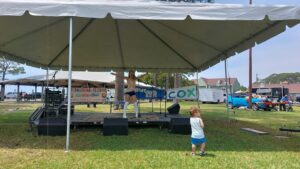Lord of Miracles
by Dave Skinner, [email protected] | Le Jardin Ombragé, Tallahassee, Florida, USA http://www.gingersrus.com
As I watched television images of the rescue attempts, and hoped for miracles from the September 19 earthquake in Mexico, I was reminded of the legendary miracles of seventeenth-century Peru. Around 1650, a group of African slaves who had been converted to Christianity formed a Brotherhood in the Pachacamilla District of Lima, Peru. One of the members, who was from present-day Angola, painted a mural of Christ on the cross on a wall at their meeting house. Then, on November 13, 1655, a major earthquake destroyed all the homes in the area and the people abandoned the district. Fifteen years later, a man named Antonio León from the San Sebastián parish discovered that the wall with its mural of Christ had miraculously survived the earthquake. León built an altar at the site and worshipped Christ at the wall. He was miraculously cured of a tumor, and soon others began to gather there seeking other miracles. A cult of mostly African immigrants gathered there every Friday night to sing prayers to the Christ image on the wall, but they did not follow the official Catholic religious practices.
When the local archbishop learned of this, he considered it a sacrilege and in 1671 the viceroy ordered that the wall be painted over. The painters and soldiers who were sent to destroy the mural experienced mysterious tremors or saw strange colors change on the image and they refused to carry out the viceroy’s orders. The worshippers protested and the order to destroy the mural was eventually rescinded. On September 14, 1671, the first Catholic mass was celebrated in front of the “Christ of Pachacamilla” and the image was later called “El Señor de los Milagros” or “The Lord of Miracles”.
On October 20, 1687, a second major earthquake destroyed much of the city, including the small chapel built near the wall, but once again the mural escaped damage and the miraculous quality of the mural was reinforced even more. Then, on October 28, 1746, the worst earthquake and tsunami in the history of Lima, leveled the city of Callao, and again destroyed everything around, except the holy mural. The church and Monastery of Nazarenas were built around the site of the mural and a copy of the image on the wall was created.
On October 18th of every year there begins a long series of processions through the streets of Lima celebrating The Lord of Miracles. A huge sterling silver litter with an image of the mural painting is carried shoulder high through the streets of Lima by a total of 4,300 “cargadores” (carriers), who are men dressed in purple robes. Taking turns in 15-minute shifts, 36 of the cargadores at a time carry the huge statue from one neighborhood to another. In front of the procession wearing purple robes and white veils, there are 244 Catholic sisters known as “sahumadoras” burning incense and behind them are 320 “cantadoras” singing hymns of praise to El Señor de los Milagros. The crowd of bystanders also wear purple and the month of October is known as “purple month” in Lima.
According to Perú Católico, Pope Francis will be coming to Lima in January 2018 and he will worship at the image of the Lord of Miracles.

